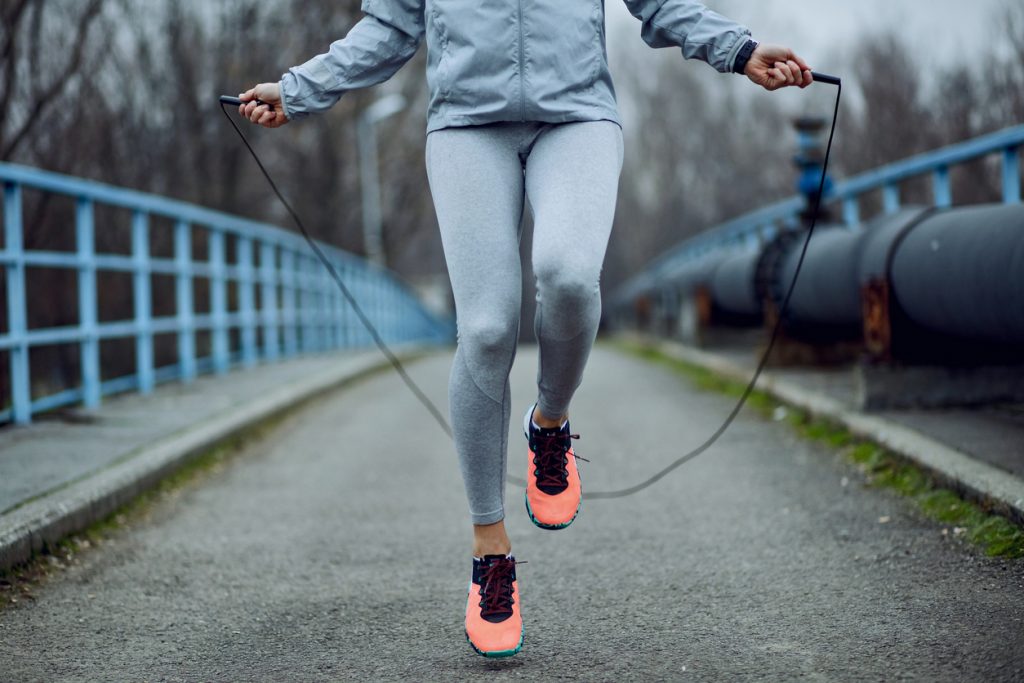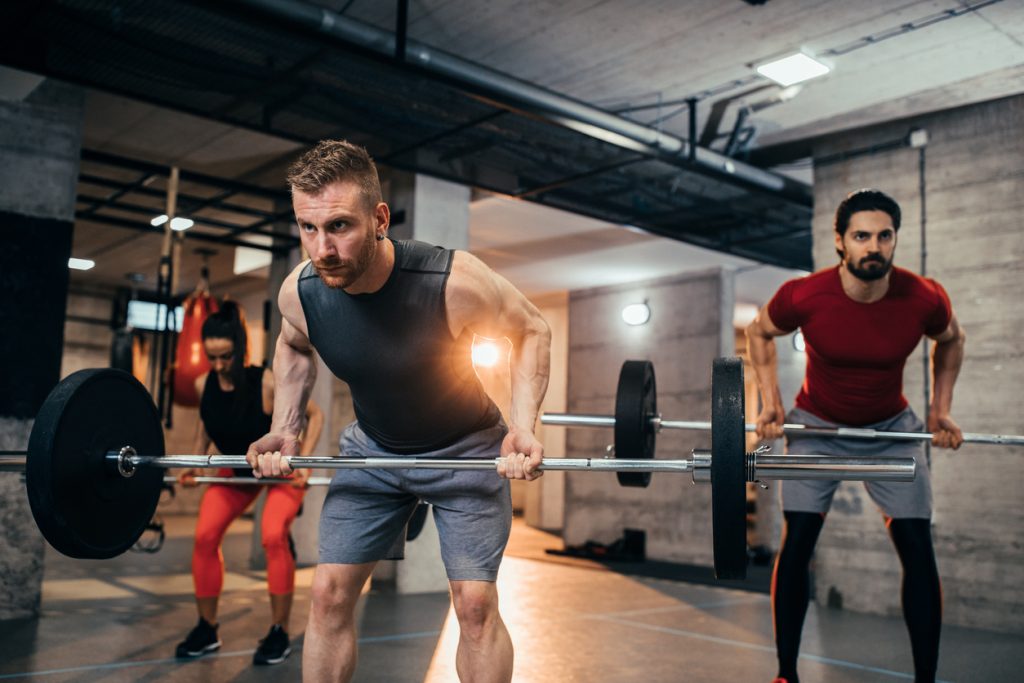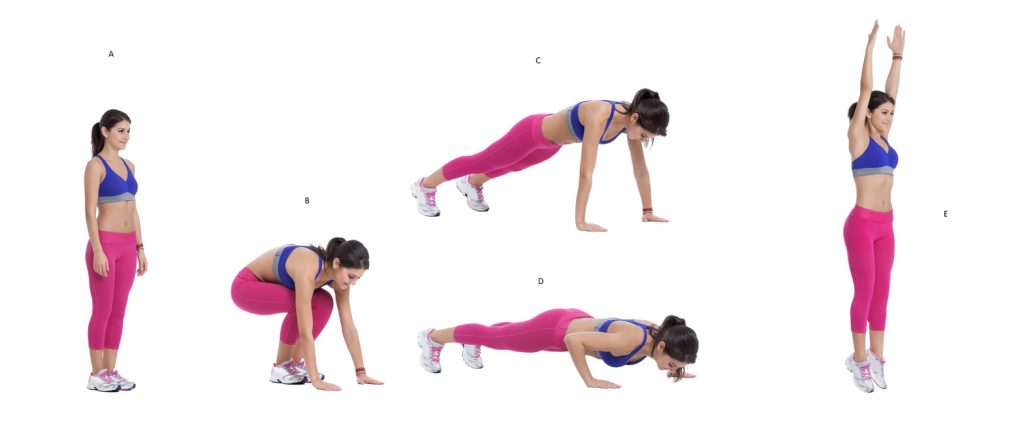Depending on the parts of the body targeted and the presence or absence of additional load, there are 4 main groups of plyometric exercises.
Upper body without load
Jump Push-ups
This is a simple exercise. Just perform a classic push-up with enough momentum during the ascent to get your hands off the ground. To start, you can perform the push-ups on your knees.
If this exercise seems easy, you can clap your hands once in the air or even take your feet off the ground. Jump push-ups will help you strengthen your pecs, shoulders and triceps.
This is a great exercise if you play ball, racket or combat sports. It increases your throwing strength.
Alternating jumping Push-ups with a ball
This is an improved version of the classic jumping push-ups. It involves performing jumping push-ups with an unstable base. In the starting position, put one hand on the ball and the other hand on the ground. During the jump, move slightly apart so you can switch hands. If your left hand was on the ground before the jump, it should be on the ball after the jump. And vice versa.
This workout not only achieves the same results as the classic jumping push-ups, but also optimizes ball catching techniques. It also helps to maintain balance.
Pull-ups
This exercise does not differ much from a classic pull-up. The principle: rely on the impulse to straighten up as soon as you find yourself down. It complements the push-ups and especially strengthens the back. You can also develop your biceps with a supine grip.
This exercise is recommended if you practice a sport that requires the use of the back muscles. These muscles support the spinal column which has to withstand multiple loads and pressures.
Lower body without load
Depth jump
This is an alternative toof the jump with your feet together. It is performed by starting up high, on a bench for example. Afterwards, you have to jump from this height, then jump again as high as possible as soon as your feet touch the ground.
To reduce the shock and store more elastic energy, it is advisable to bend your legs moderately on arrival. But bent legs also allow you to jump higher.
To increase your performance, you can opt for a higher support point, such as a jump box. You can also put an obstacle to jump, like a hurdle, after bouncing.
This is a complete workout that strengthens most of the leg muscles. It is effective in optimising vertical rebound in basketball or volleyball.
Jump squats or jumping jacks with feet apart after bending
This exercise consists of performing a squat, then a jump without changing the position of the feet. You need to be quick on this exercise and avoid taking time once you land. However, in order to build up elasticity, you need to get down low enough.
For advanced amateurs, you can use dumbbells, a dynamic bar or a weighted waistcoat. As for beginners, do classic, but very quick squats first.
Jump rope
It is advised to do the jump rope during a warm-up. Indeed, this exercise warms up almost all muscles and joints. However, the legs do not bend enough during jump roping.
For plyometrics, it is recommended that you do jumps with your feet together or on one foot. Once you adopt this movement, you can jump forward, backward and sideways while using the rope.
Double under is also effective. The goal is to make two quick turns of the rope for one jump. They force you to be explosive and stay in the air long enough to get through that double rope turn.
Jumping jacks
Stand up for the initial position. Then do a jump with your feet apart and your arms raised above your head. Without stopping, directly arrange a second jump to get into the starting position. This is not a difficult exercise. You can also do it during the warm-up.
The bends are not considerable during this exercise. To turn it into a successful plyometric workout, you can complement it with a half-squat when your spread feet touch the ground. It is also possible to bend your legs when you land with your feet together. This may look easy on the muscle side, but it is quite difficult on the balance side.
This is a basic plyometric exercise. It consists of:
- performing jumps with joined feet, going as far forward as possible,
- to perform the next jump immediately.
Although this type of jump is specifically practised in athletics, it is also interesting for other sports.
This exercise helps you to improve your forward jumping ability while perfecting jumps and speed. It is perfect for all sports.
Bouncing Steps
The premise of this exercise is simple: you press into the steps by bringing your knees up high with each swing. This allows you to build up maximum energy and speed for the next jump.
This is a movement similar to what you see in athletics in the run-up to the high jump, for example. It is a very important training for an athlete. However, it is also recommended for certain activities that require moving jumps. This includes basketball, volleyball and football.
Lateral jumps
It consists of executing a jump with joined feet by going as far as possible to one side and then to the other. This jump is usually performed with feet together. But for greater efficiency, it is advisable to stand on one foot, jump as far as possible to the opposite side and land with the other foot. And vice versa. Lateral jumps are very beneficial to improve your lateral movements while optimizing explosiveness.
This exercise is perfect for sports where fast movement on the court is paramount. Examples : tennis and boxing.
Jumped Lunges
This is an exercise similar to the jumping strides, except that it is performed on the spot. To perform a lunge, one of your legs should go forward and the other back. Stand tall and take a big step forward. Bend the supporting leg so that it forms an angle of about 90° and stop moving down before the back knee touches the ground.
For the plyometric variant, jump with the legs reversed (front to back).
Are you doing this exercise for the first time? Try the classic lunges first with more drive.
Jumping lunges are one of those exercises that optimise your balance and develop your support strength. They are recommended for tennis and football players.
Upper body with load
Dumbell bench press
Lying on your back on a bench, raise the loaded dumbell over your pectorals. Let the opposition strength of your pecs help you. For the plyometric version, do not stop at the end of the descent. Instead, use the momentum to move on to the next movement.
This exercise will considerably strengthen your pectoral muscles, shoulders and biceps. It will also improve your throwing power, momentum and percussion.
The plyometric version of the bench press is perfect for many sports. These include ball sports and combat sports.
Rowing
Stand with your torso slightly tilted forward while keeping your back straight. Extend your arms, lift a loaded Olympic barbell (or dumbbells) and bring the bar towards your abdomen. Remember, always perform the push-up when the bar is at its lowest point.
This is an exercise that puts a lot of strain on the back muscles as well as the shoulders and arms, especially the biceps, when held in a supinated position.
You can optimize your throwing and gripping power.
Rowing will also help you develop your back muscles while protecting your spine.
Rowing
This is a classic strength training workout that is performed by pulling a barbell on a pulley in a seated position, with your chest tilted back and straight. The movement is performed dynamically and without stopping.
This is a movement that will especially help you to develop your back muscles.
This is a very beneficial exercise, as it requires less strength than the pull-up and gives excellent stability than the barbell rowing.
The prone pull-up is well suited to beginners. It is also still beneficial for top athletes, provided proper loads are used.
Medicine ball throws
Here the aim is to make throws at a fairly small target that is high up. This is to improve both dexterity and explosiveness on the throws.
The medicine ball weighs several kilos. This is why this exercise is perfect for boosting the strength and stamina of the shoulders and arms. It is a movement that is especially dedicated to ball sports. But boxers can also benefit from the transmission of energy to the upper body through leg presses.
If you want to focus on explosive strength, do quick throws at a wall, standing close to it. This position allows you to do a sequence of throws. When done in long sets, the effectiveness of this exercise on endurance is considerable.
Low body with load
Squat
This is the same exercise listed in the unloaded exercises but with an additional load.
Calf
To not neglect this part of the body, train using a press machine (the same one used for the thighs), on your toes to emphasize the calves. To be energetic with this type of training, opt for light loads. Although the calf muscles are small and often overlooked, they play an important role in explosive jumps and speed. It is therefore essential to work them.
Small focus on Burpees
This is an exercise that does not fit into the above categories.
The Burpees is by far the best plyometric exercise. It strengthens all parts of the body. To perform it:
- start from a standing position,
- bend your legs to perform a squat,
- on landing the squat, put both hands on the floor and throw your feet far back to get into a plank position,
- follow with a push-up,
- in a short, quick movement, return your feet to the starting position.
- with this squat position and legs well bent, jump as high as possible.
This is a complete workout that works most of the muscle groups in the body, making it a popular and effective exercise for all sports.
Our pro tips
Plyometrics is very physically demanding. It is also a rather complex training. Plyometrics is strongly advised against for beginners who can get injured because of the speed of the movements.
Advice: first dominate the movements in static and dynamic mode before starting the actual plyometrics.
As plyometrics is very demanding on the body, frequent training is not recommended. Two workouts per week is more than enough, in which case the fatigue and negative effects will outweigh the advantages and benefits.
It is also essential and recommended that short sets are used in plyometric exercises. Remember that each exercise requires considerable physical strength. On long sets, exhaustion will quickly be felt, which will obviously affect your movements. Indeed, you must remember one essential thing: in plyometrics, quality comes before quantity.
For beginners, prefer bodyweight training. It is less abrupt and will give you time to adapt to the exercises and the rhythm set.
When a competition is approaching, stop doing plyometrics at least two weeks beforehand. This will give your body a chance to regain its strength and be more efficient and available on the day.
Another point: warming up is very important before performing plyometric exercises. As the movements are short and powerful, sprains or other more serious injuries can occur at any time, especially if the muscles are not properly warmed up.
As plyometrics relies on the elasticity of the muscles, it is essential to stretch to optimise this elasticity. But be careful, as stretching can worsen small muscle tears caused by training, so do not perform stretching movements before or after a sports session. Also remember that stretching is not a prolonged process.
To conclude
The ideal plyometric programme has not yet been developed. It is up to you to choose the exercises and training sets that are suitable for your physical condition and sporting activities. In practice, you can even change and invent exercises as you progress.
It is also recommended to carry out a fullbody programme to develop and work all parts of the body. The overall progress will be more satisfying. So choose exercises that give you the opportunity to work your pecs, back and legs. The best exercises in this category are jumping push-ups, jumping pull-ups and jumping squats. Don't forget about the cardiovascular system either, which you can optimize with exercises like split running.



